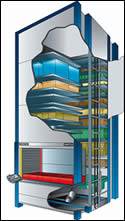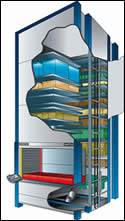How to Handle Your Heaviest Molds
Using the appropriate wheeled transporter technology moves large molds freely throughout the shop.
Moving molds that weigh 30 to 70 tons and more to and from the toolroom can be a chore, not to mention the time and effort the mold change crews spend in struggling to get the molds in and out of the machines. The use of the appropriate wheeled transporter technology offers a new option for moving the largest of molds freely between all areas of the plant.
The features to consider in your selected wheel transporter technology include:
- The capability of carrying unlimited weight across virtually any type of existing plant floor. It should have six, eight, 10 or more axle assemblies that are individually fluid suspended to assure that every tire is carrying only its share of the load, regardless of depressions, ramps or other serious floor irregularities.
- Omni directional travel ability, which allows the vehicle to travel sideways, rotate about its own center as well as lift and lower at the touch of a button. These features provide mobility that has never before been available for moving massive loads through congested spaces. For the toolroom, this means freeing up valuable space, because molds can be stored almost anywhere, yet still have near instant access for processing.
- Either a self-loading mold changer that carries molds at near the right height for machine insertion or a very low-deck platform carrier that transports molds between process areas and to and from the toolroom.
- Every wheel should have its own drive motor to accommodate travel and steering. Differential steering is accomplished by varying the wheel’s rotation speeds or even reversing the rotation as necessary for whatever maneuver the operator directs. The complexity of controlling the speed and direction of every wheel on these multi-axle carriers becomes a simple task for the onboard computerized control. The operator simply controls all movement with great precision from a tiny joystick on a tethered handheld remote.
Mold Change in Action
In a typical mold change with the right wheeled transporter technology, ready molds will be taken from a storage area and can be carried on either or both of the twin roller decks. For an actual mold change, the operator will maneuver the transporter in parallel to the next machine due for a mold change. The operator will stop with an empty roller deck roughly laterally aligned with the mold to be removed. With a touch of a button, all of the axles will turn 90 degrees and the transporter will now move sideways to the side of the machine. The outriggers will lower and the entire transporter will be lifted to a matching height with the platen rollers.
When the spent mold has been rapidly brought onboard and secured, the transporter will lower to floor contact, where again all of the wheels turn to move the transporter forward to align for insertion of the new mold. Again the outriggers lift the transporter to the required height and the new mold is rolled into the machine—quickly, efficiently and safely.
Using all-wheel drive and all-directional steering, wheeled transporter technology can travel on 12 to 20 or more solid urethane tires. If the loaded transporter is going to stop for any extended period of time, the transporter simply lowers to trans-fer its weight onto outrigger pads to avoid temporary flats.
In a busy toolroom, space is often a serious problem. Having that capability to move molds freely and quickly to remote storage areas can put a new element in a toolroom’s list of capabilities.
Related Content
Line Width vs. Depth Ratio in Laser Engraving
A laser does not produce 90-degree sidewalls. It requires a certain amount of draft in order to produce the required pattern.
Read MoreIt Starts With the Part: A Plastic Part Checklist Ensures Good Mold Design
All successful mold build projects start with examining the part to be molded to ensure it is moldable and will meet the customers' production objectives.
Read MoreHow to Eliminate Chatter
Here are techniques commonly used to combat chatter and guidelines to establish a foundation for optimizing the moldmaking process.
Read MoreHands-on Workshop Teaches Mold Maintenance Process
Intensive workshop teaches the process of mold maintenance to help put an end to the firefighting culture of many toolrooms.
Read MoreRead Next
Selecting a Vertical Storage And Retrieval System for Moldmaking Applications
Vertical systems, when properly planned and integrated into daily operations, can significantly reduce operating costs.
Read MoreHow to Use Strategic Planning Tools, Data to Manage the Human Side of Business
Q&A with Marion Wells, MMT EAB member and founder of Human Asset Management.
Read MoreReasons to Use Fiber Lasers for Mold Cleaning
Fiber lasers offer a simplicity, speed, control and portability, minimizing mold cleaning risks.
Read More


















